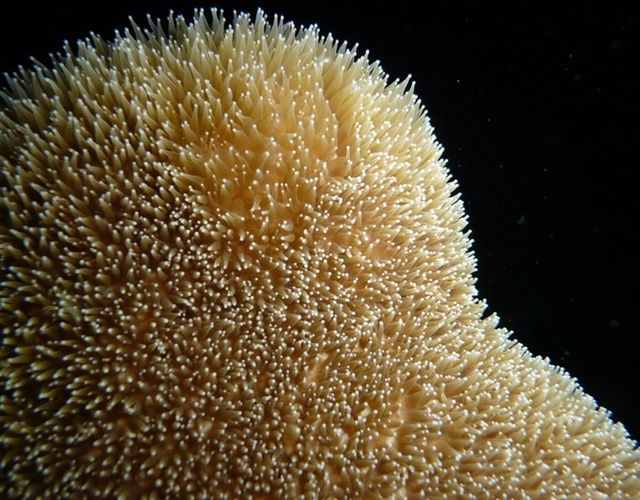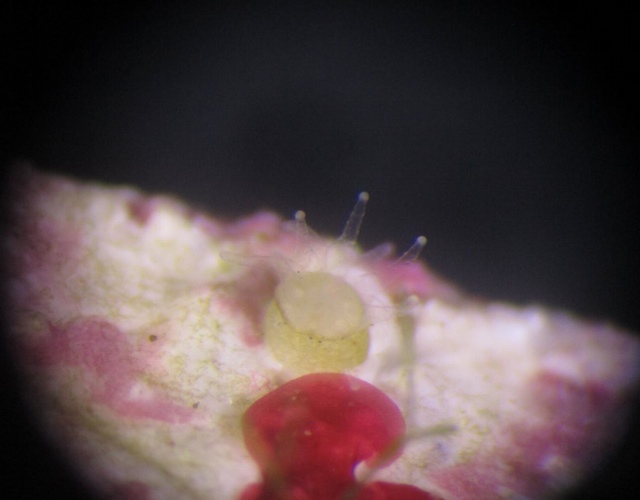Pillar coral. Photo: Mark Vermeji.
Coral reefs are often called "the rainforests of the sea," and for good reason. These living mega-structures are among the most biodiverse habitats on the planet, and certainly the most lively of shallow aquatic ecosystems. According to NOAA, reefs are home to about 25 percent of all marine life, which shakes out to about one million species. That is especially impressive given that these invertebrates only take up about one percent of the ocean floor.But unfortunately, like rainforests, coral reefs are disappearing rapidly due to human activity. Overfishing and pollution have disrupted these intricate environments, and climate change is further threatening their development. This destabilization of a key marine environment is occurring incredibly rapidly, with scientists projecting total loss of the Caribbean coral reefs within the next 20 years.This ecological freefall could have dire consequences not just for the species that live in reefs, but also for those who depend on them—including humans. That's why conservationists have been fighting to protect existing reefs, and restore those that have already been lost.For example, a team based out of the CARMABI Foundation on the island of Curaçao has been investigating how to essentially "reforest" these undersea jungles, with a focus on the Dendrogyra cylindricus coral. This species, known commonly as pillar coral, packs a particularly powerful ecological punch because of its large protective branches (which also serve as a handy buffer against storm surges). Unfortunately, it is very sensitive to bleaching effects and diseases caused by warming global temperatures, and its swift decline has spurred the International Union for Conservation of Nature (IUCN) to declare it vulnerable.The CARMABI team, led by coral expert Kristen Marhaver, began their research into pillar corals by unlocking the riddle of the species's reproduction. These corals are incredibly specific about when they release their sperm and eggs into the seawater, and because of these mysterious preferences, nobody had seen a juvenile in the wild for 30 years.By extrapolating from data collected on a species called elkhorn coral, Marhaver and her colleagues were able to pinpoint the most likely timing for this annual undersea lovefest. Like some kind of Medieval tale, it ended up being three nights after the August full moon, about two hours after sunset.Because pillar corals release sperm into the water first, followed soon after by eggs, the team was able to collect plenty of samples of both using syringes, funnels, and nets. From there, the researchers successfully fertilized the coral eggs in laboratory conditions, and, for the first time ever, nurtured juvenile larva for a period of seven months.
This species, known commonly as pillar coral, packs a particularly powerful ecological punch because of its large protective branches (which also serve as a handy buffer against storm surges). Unfortunately, it is very sensitive to bleaching effects and diseases caused by warming global temperatures, and its swift decline has spurred the International Union for Conservation of Nature (IUCN) to declare it vulnerable.The CARMABI team, led by coral expert Kristen Marhaver, began their research into pillar corals by unlocking the riddle of the species's reproduction. These corals are incredibly specific about when they release their sperm and eggs into the seawater, and because of these mysterious preferences, nobody had seen a juvenile in the wild for 30 years.By extrapolating from data collected on a species called elkhorn coral, Marhaver and her colleagues were able to pinpoint the most likely timing for this annual undersea lovefest. Like some kind of Medieval tale, it ended up being three nights after the August full moon, about two hours after sunset.Because pillar corals release sperm into the water first, followed soon after by eggs, the team was able to collect plenty of samples of both using syringes, funnels, and nets. From there, the researchers successfully fertilized the coral eggs in laboratory conditions, and, for the first time ever, nurtured juvenile larva for a period of seven months. "Now that we've successfully reared juvenile pillar corals in the lab, not only can we study them in more detail to find out what factors could be threatening their survival in the wild, but it also means that we can try to out-plant a small number back to the reef," said Marhaver in a statement."We don't know if this will work and it is certainly not a cure-all for the reef," she continued. "But especially in such a rare coral species, a tiny boost of a few new individuals could make a big difference in their genetic diversity, allowing their populations to adapt and become more resilient to the changing environment in the oceans."The team's study appears today in the journal BMC Ecology, and Marhaver will also be presenting the results at the TED Conference at 4pm Pacific Time tomorrow. Hopefully, the new research will encourage more investment into bringing vulnerable corals back from the brink, so the millions of species that depend on them—on and off land—can continue to thrive.
"Now that we've successfully reared juvenile pillar corals in the lab, not only can we study them in more detail to find out what factors could be threatening their survival in the wild, but it also means that we can try to out-plant a small number back to the reef," said Marhaver in a statement."We don't know if this will work and it is certainly not a cure-all for the reef," she continued. "But especially in such a rare coral species, a tiny boost of a few new individuals could make a big difference in their genetic diversity, allowing their populations to adapt and become more resilient to the changing environment in the oceans."The team's study appears today in the journal BMC Ecology, and Marhaver will also be presenting the results at the TED Conference at 4pm Pacific Time tomorrow. Hopefully, the new research will encourage more investment into bringing vulnerable corals back from the brink, so the millions of species that depend on them—on and off land—can continue to thrive.
Advertisement
Advertisement
